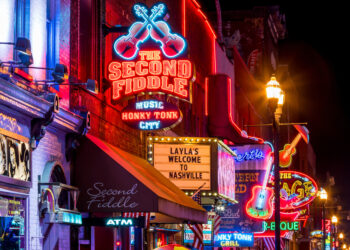Napoli’s rugged beauty and energy charm any visitor; add to this its diverse art, the heart-warming locals, and an array of cultural assets for an extraordinary “La Dolce Vita” experience. If you’re wondering what to do in Naples, there are plenty of unique places and monuments worth visiting as Italy is one of the top European destinations for tourists.
Two different itineraries are planned for those who have a day to spend in the city below, ‘classica’ (the classic way) and ‘verace’ (off the beaten path).
Affiliate Disclaimer: Our blog posts may contain affiliate links. If you make a purchase through these links, we receive a modest commission at no extra cost to you. These commissions help us fund our team of travel writers, allowing us to continue providing you with the latest travel news, tips, and inspiration. Your support keeps this blog alive and thriving, and we appreciate it immensely. Thank you!
What to do in Naples: Napoli Classica Itinerary
The Napoli ‘classica’ itinerary showcases the most renowned culture, art, and architecture throughout the city. While the town itself is adorned with unique sights and historic landmarks, this itinerary will give you a classic insight into the city.
Start With Picturesque Panoramas: Castel dell’Ovo
First on this classic itinerary is a castle of medieval architecture with a peculiar name. Castel dell’Ovo is a Norman seaside castle located on the island of Megaride, and its name literally translates to Castle of The Egg in Italian. Legend says that a Roman scribe buried an egg on the site where the castle stands to preempt when the castle will fall, stating that the egg will crack. The castle offers beautiful panoramas across the Gulf of Naples from its external walls.

Admire Decadent Design: Piazza del Plebiscito
The next location on the Napoli ‘classica’ itinerary is the grand Piazza del Plebiscito. Framed with show-stopping architecture, this large piazza in the centre presents a different side of the humble city. Locals to meet here before heading towards their favourite place for an aperitivo. It is home to many of Naples’ primary spectacles, including the Church of San Francesco di Paola. So now is the opportunity to take in the city’s glorious architecture before a morning coffee break…
While in Piazza del Plebiscito, take a break to pay a visit to The Gran Caffè Gambrinus. Heir to the historical Napoli coffee tradition, the 19th-century coffee house serves some of the city’s finest refreshments and pastries. The elegant interior is the perfect setting for a spritz later in the evenings, with Oscar Wilde and Mussolini visiting in the past.

The Oldest Theatre In Europe: Teatro San Carlo
Following a coffee and pastry break, you should be ready to soak in some more history. The San Carlo Theatre is the oldest working theatre in Europe, and it is directly connected to the Royal Palace. Both its interior and exterior are sights to behold. If time allows, consider getting a ticket for one of the theatre’s infamous opera shows. You won’t regret it.

A Classic Pizza: Antica Pizzeria Brandi
What to do in Naples if you’re hungry? Of course, go for an authentic pizza! Naples is the birthplace of pizza, with restaurants worldwide replicating the traditional Neapolitan recipe. Try Antica Pizzeria Brandi, located on a side street. Offering a slice of the city’s history with every mouthful, visitors to the restaurant are warmly greeted and welcomed in. Choose from a selection of delicious pizzas ranging from the classic Margherita to fresh Prosciutto di Parma.
Art and History: Palazzo Reale
After lunch, it’s time to take a leisurely stroll back towards the centre to take in the stunning Palazzo Reale. Originally planned as a 16th-century palace to mark Spanish glory under the ruling, the stunning Palazzo Reale houses the remarkable collection of the Museo del Palazzo Reale. In the Palazzo Reale Museum, you’ll find baroque and neoclassical furnishings as well as art ranging from detailed tapestries to delicate porcelain sculptures. You’ll also find many other city highlights here, including the Teatrino di Corte, a luxurious private theatre constructed in the 18th-century.

Visit The Old Entrance To The City: Piazza del Gesù
This lively, bustling square in the city’s historical centre is dominated by the spiked Chiesa del Gesù Nuovo. This 18th-century church stands as an architectural delight. For centuries, the square was the western entrance to the city of Naples; however, two modifications taking place in the 16th-century saw the piazza’s proportions be redesigned to its modern-day layout.
Colourful History: Santa Chiara Church and Cloister
Santa Chiara is a significant religious complex in the city. It includes the Church of Santa Chiara, a monastery and tombs, and an architectural museum. In the heart of the complex, the beautifully subdued church carries with it centuries of history. Though the church was heavily damaged throughout WWII, its colourful frescoes and 17th-century majolica tiles still remain. Outside of the church’s cloisters, you’ll find a small yet perfectly curated museum housing the ruins of the 1st-century spa complex excavated not far from the church.
Cultural Insights: Piazza San Domenico
In the centre stage of Piazza San Domenico stands the 18th-century Guglia di San Domenico, an impressive obelisk designed by Cosimo Fanzago, Francesco Antonio Picchiatti and Domenico Antonio Vaccaro. The name given to the obelisk pays homage to the saint who eradicated the plague of 1656. Another historical monument in the piazza is the Chiesa di San Domenico Maggiore, a beautiful Gothic church featuring a face in its facade.

Museum Jewels And Iconic Art: Cappella San Severo
The Museo Cappella San Severo houses some of the world’s most profound artworks in the historical centre. Inside the museum, you’ll find a collection of baroque creativity evoking mystical beauty and allure across all of its exhibits. The museum showcases masterpieces, including the Veiled Christ and Disillusion.
A Slow Paced Walk: Via San Gregorio Armeno
Continue your relaxing afternoon by taking a slow-paced walk down one of the city’s most characteristic streets, Via San Gregorio Armeno. As you move along the cobbled pathway, you’ll stumble upon perfectly placed markets offering locally made cribs (presepi) and much more.
A Dinner With Breathtaking Views: Zona Marechiaro
Naples is a gold mine for Italian cuisine. In fact, many of the country’s finest dishes originate from the city. While there is an abundance of renowned restaurants to choose from, the perfect ending to a day here is one where dinner is paired with a breathtaking view. Zona Marechiaro is a hotspot for some of the city’s most sublime restaurants offering a delicious seafood and pasta menu.
What to do in Naples: Napoli Verace Itinerary
The ‘verace’ itinerary takes inspiration from the true Naples, taking visitors away from the obvious and off the beaten path. By following this itinerary, you’ll still have the opportunity to relish the city’s rich history and culture. Still, you will also be presented with some of Naples’ best-kept secrets.
If you’re wondering what to do in Naples to experience the city like a local, here is the ultimate itinerary to see all the city’s glory and humbleness.
Culture And History: Certosa di San Martino
Start the day right with immersive cultural and historical insights at a former monastery known as Certosa di San Martino. Standing as a museum today, the site offers baroque beauty atop a cliff overlooking the gulf. Inside the museum, you’ll be treated to a collection of splendid paintings and intricate frescoes completed by some of Naples’ best 17th-century artists. Then, delve deeply into the historical architecture of the old monastery as you make your way down grand corridors and into rooms to admire marble sculptures.
Quartieri Spagnoli, Pedamentina, La Pignasecca
Art lovers who wonder what to do in Naples should know that the city’s vibrant art scene takes visitors from elegant masterpieces to more rugged and political street art. With such far-reaching diversity in creative expression in the city, there’s far more than a day’s worth to admire. If you’re interested in folklore culture that drives much of the art produced in the city, head towards the Quartieri Spagnoli (The Spanish Quarter). Here you’ll find streets lined with artisan shops, lively markets, and art adorning the walls that cradle the residents and merchants here. From the famous wall painting of Diego Armando Maradona, Naples’ biggest football idol, to hyper-realistic works and even Madonna With A Pistol by Banksy, there are lots to admire in the area for art fans.

Take an ancient staircase of 414 elongated steps that date back to the 14th-century and enjoy a shortcut across the city not known by all. Linking Corso Vittorio Emanuele with the Certosa di San Martino on the Vomero hill, the Pedamentina will give you undoubtedly the best panoramic view across the city and beyond. Once you’ve completed the ascent, you’ll be rewarded with stunning vistas stretching all the way to Mount Vesuvius.

After climbing the stairs, you’ve likely worked up an appetite. Again, while most travel guides swear by spending lunch in a pizzeria, this itinerary offers a different cuisine experience. La Pignasecca is a market with stalls offering everything you could imagine, but best of all, delicious food made by locals. Here you can find the infamous pizza a portafoglio (folded wallet pizzas), ‘o pere e o muss’ (an ancient Neapolitan dish) and pasta with ragù, all of which are traditional dishes worth trying. The difficult decision is deciding on only one!
A Romantic Folk Dinner: Posteggia Napoletana
‘Posteggia Napoletana’ is the name given to the Napolitan tradition that is centuries old. Translating to ‘park’, posteggia is the local name given to a type of musical performance that orients around a particular way of making music. Today, the old tradition of small bands composed of a singer and a folk string instrument player (such as a mandolin) is still alive. Hundreds of years ago, the performances were solely to woo a loved one by serenading melodic music. You can head to the Quartieri Spagnoli for an ultimate romantic dinner; many of the restaurants here feature these small ‘Posteggia’, providing an experience for all the senses.











